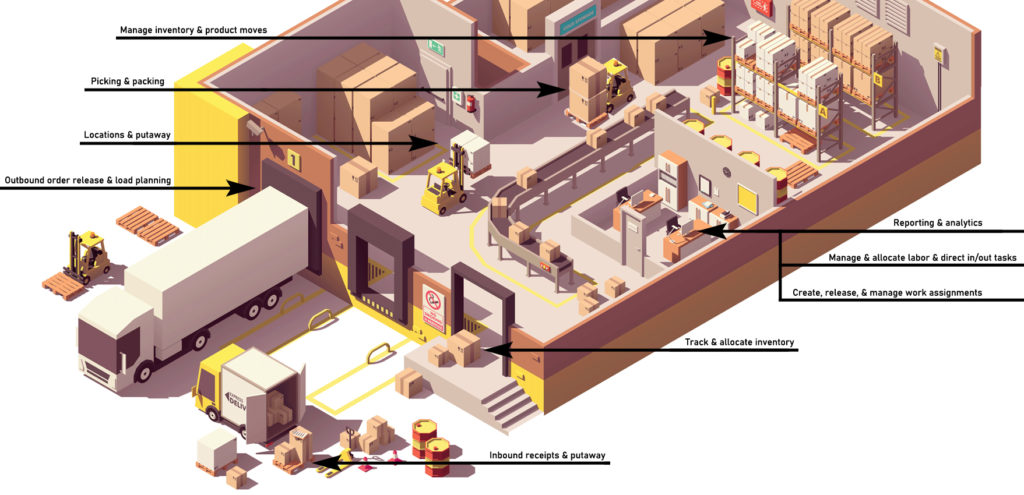Most Common High-Level WMS Questions Answered

We’ve been focused and specific in our last handful of articles, so let’s take a step back for a change and answer the most common higher-level warehouse management questions around. These days “around” really means “Internet” of course. So, if you are a grizzled WMS vet then you may be more interested in one of our other articles or you can stay tuned to see what web searchers are most curious to know in the realm of warehouse management.
We have compiled a list of the top autocomplete phrases and questions based on the keyword “warehouse management” using various search engine tools. The majority of the resulting questions are below. We threw out a handful of repeat results, a few weird ones (it is The Internets after all), and we tossed in a few extra at the end just to flesh out the list a bit more.
What’s a Warehouse Management System (WMS)?
The core functionality of a WMS is to help manage and streamline day-to-day operations in a warehouse or distribution center, and “guide” inventory through receiving, put-away, inventory management, picking, and shipping while optimizing these processes and advising on inventory replenishment.
What is the purpose of a WMS?
To help reduce errors, fulfill orders more rapidly, increase visibility, reduce cost, and improve the overall optimization of processes in a warehouse or distribution center – and at the end of the day reap all the benefits mentioned elsewhere in this article.
The return on investment of going from a true manual warehouse to a WMS can take up to six months, as it is a drastic change…Additionally, a Warehouse Labor Management (WLM) system that optimizes and orchestrates labor tasks…Both combined can give anywhere from 35 to forty percent ROI depending.
Why is a WMS important?
Larger warehouses and distribution centers have no choice but to use a WMS in order to compete in today’s supply chain. They must maintain high efficiencies and run at the lowest cost possible. The advantage of having the most state-of-the art, modern “warehouse of the future” is totally negated if its isn’t managed well.
When new stock arrives at a busy warehouse you don’t want a human determining the best place to store it. The WMS knows right away, as it has instant access to your past and current inventory as well as possible storage locations. Consider a situation where a customer sends an order, a WMS instantly checks to see if the product is available. Imagine if every time a human being manually verified the order against the available stock.
Some customers can even insist that your company adopt a WMS due to their compliance requirements such as:
- Label and packing list specifications
- Picking consolidation and segregation requirements
- Inventory segregation for specific customers
- EDI data compliance such as Advanced Ship Notice (ASN)
- Enforcement of inbound and outbound quality checks
How can a WMS reduce costs?
- Better accuracy and visibility of inventory
- Improved efficiency of putaway and later, order picking
- Reduction of picking and shipping errors
- Elimination of manual processes via automation
- Allows for ability to adopt and integrate the latest warehouse technologies
- More accurate forecasting improves purchasing decisions

How does a WMS work?
It operates based on a variety of data and rulesets including information on inventory SKUs, productivity, and locations. This database is essentially the backbone of your warehouse management, and the WMS is only as good as the accuracy of the data provided. Incorrect expiration dates can result in valueless (and possibly smelly) inventory wasting space, or if the wrong locations are assigned to inventory, then your warehouse personnel have to waste time dealing with the resulting discrepancies.
How to improve Warehouse Management Systems?
- Stay current with your WMS and latest features
- Quickly address any defects and/or process flow issues
- Consider upgrading any legacy hardware or processes
- Conduct regular user training
- Frequent order reconciliations, and quickly addressing discrepancies
- Regular meetings with warehouse users and managers on performance
- Integrate with ERP and/or LMS
- Adequate testing phase before any Go Lives
- Fully utilize available features – can you use the returns management component?
What is the best WMS?
We like Blue Yonder, but certainly your team should compile a list of requirements and research solutions that fits your specific needs and size/scale. There are many aspects to investigate, but among the top of the list you should consider what challenges you expect to resolve now and what do you expect down the road. The WMS should also compatible with your existing software (ERP integration is key) and hardware (computers, terminals, etc…), and be sure to research clearly demonstrated real-world ROI against operations similar in size/scale to yours. If you are unsure as to what makes sense, feel free to reach out to us for advice as we do this for a living.
How do you learn WMS?
Any WMS worth its salt has some form of e-learning program, and many of the prominent WMSes offer industry-respected certifications. Certainly, it’s a boon to have real-world experience working in physical warehouses before learning how to best manage them or at the very least a handful of in-depth tours would help.
Bonus Questions:
What are the most common WMS concerns and/or pitfalls?
Check out a blog article answering this very question.
Can I see a real-world example of a company adopting WMS?
Here is a case study on one of the largest beverage companies in the world adopting Blue Yonder WMS.
Feel free to drop us a line if you have any questions, or feedback on the most common high-level WMS questions! We are a reseller of Blue Yonder WMS, and enjoy solving supply chain execution challenges.
This post was written by:

James Prior Sales Ops Manager James has been working in software pre-sales and implementation since 2000, and more recently settled into working with a pre-sales team and occasionally writing blog posts. Drop him a line at: james.prior[at]tryonsolutions[dot]com.
Recommended Content
Successfully Upgrading to Blue Yonder SaaS Despite Mid-Project Scope Expansion
This case study explores how our team successfully managed and completed a Blue Yonder SaaS upgrade despite significant mid-project scope expansion. Discover the challenges faced, strategic adjustments made, and best practices applied to keep the project on track,...
6 Levers for Smarter WMS Support
Whether you're juggling school drop-offs, remembering a birthday party, or trying to reply to that one group text before dinner hits the table, modern life pulls us in a hundred directions at once. That constant pressure to keep up, stay flexible, and deliver—no...
Executive Checklist – Is Your WMS Supporting Business Strategy
This executive checklist from Tryon Solutions helps leadership teams assess whether their Warehouse Management System is truly aligned with business strategy. Explore key areas like scalability, customer experience, operational efficiency, and innovation to identify...
From Cost to Value-An Executive Guide to WMS ROI
Unlock the full ROI of your WMS with this executive guide from Tryon Solutions. Discover how services like testing, integration, and continuous optimization drive long-term value far beyond go-live.
WMS Lift-and-Shift the Top 10 Reasons to Move from On-Prem to SaaS
Over the last couple of years there has been a major push on all enterprise systems to move to the cloud. This includes ERP, CRM, HRIS, PLM, SCM, BI, MES, etc. The acronyms could go on forever. Each organization has their reasons for the move, but most fit into three...
